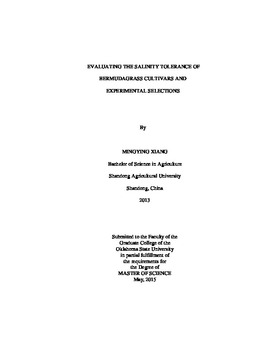| dc.description.abstract | Bermudagrass is a highly productive, warm-season, perennial grass that has been grown in the United States for turfgrass, forage, pasture, rangeland, and roadside use. Many production and reclamation sites across the United States are affected by soil salinity issues. Identification of bermudagrasses with improved salinity tolerance is important for the successful implementation of bermudagrass production and reclamation of salt affected sites and/or with use of saline irrigation water. In this project, the relative salinity tolerance of seven clonal-type bermudagrasses and 10 seeded bermudagrasses, including industry standards and Oklahoma State University (OSU) experimental lines, were determined. The newly developed experimental lines and newly released cultivars by Oklahoma State University that had shown improved cold hardiness and improved spring dead spot tolerance were included in the study. The experiment was conducted under a controlled environment with six replications of each treatment. Four salinity levels (0, 15, 30 and 45 dS m-1) were used to test the 17 bermudagrass entries, and the relative salinity tolerance among entries were determined by the normalized difference vegetation index (NDVI), digital image analysis (DIA), leaf firing (LF), turf quality (TQ), shoot dry weight (SW), shoot vertical growth (VG) and dark green color index (DGCI). Results indicated that there were variable responses to salinity stress amongst the entries studied. As salinity levels of the irrigation water increased, turf quality decreased and leaf firing increased. At the highest irrigation water salinity level (EC = 45 dS m-1), the canopy green leaf area as measured using DIA ranged from 3.07% to 24.72% and 4.97% to 16.11% in the clonal and seeded trials, respectively. Overall, �Princess 77� and experimental entry OKC1302 provided the highest level of performance in the seeded and clonal trials, respectively, at the 30 dS m-1 salinity level. The parameters LF, TQ, NDVI, DGCI, SW, VG, and DIA were all highly correlated with one another, indicating their usefulness as relative salinity tolerance measurements. | |
